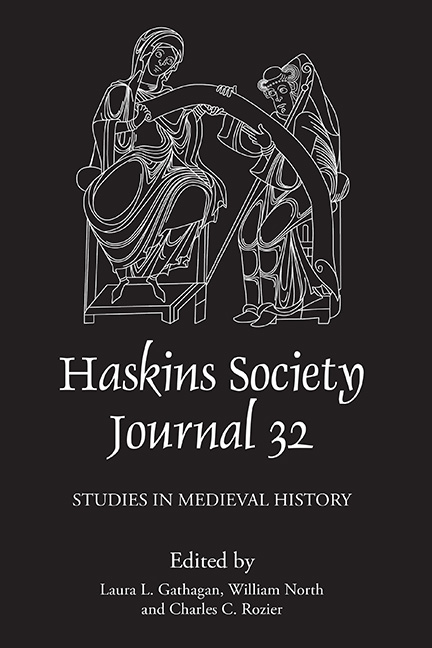Book contents
- Frontmatter
- Contents
- List of Illustrations
- Editors’ Note
- Abbreviations
- 1 Nearly-Not Miracles of the Carolingian Era: A Hypothesis
- 2 Noble Fathers and Low-Status Daughters in the Eleventh Century: Rilint, libera, and Hiltigund, presbyterissa
- 3 The Norman Conquest of England, the Papacy, and the Papal Banner
- 4 Ostmen, Normans, or Norwegians? Names and Identities in the Irish Sea World c. 1100
- 5 The Origins of Administrative Lordship in Medieval Flanders: A Reassessment
- 6 Multiple Allegiance and Its Impact: England and Normandy, 1066–c. 1204
- 7 The Wiley Lecture: Monsters in Anglo-Norman Historiography; Two Notes on William of Newburgh’s Revenants
- 8 A Female King or a Good Wife and a Great Mother? Seals, Coins, and the Epitaphic Legacy of the Empress Matilda
- 9 Harangue or Homily? Walter Espec, Deuteronomy, and the Renewal of the Covenant in Aelred of Rievaulx’s Relatio de Standardo
- 10 Anger Management: Modeling Christian Kingship in Peter of Blois’s Dialogus
- 11 In His Name: Religion as Administrative Strategy in Thirteenth-Century Champagne (and Navarre?)
- 12 Warhorse Markets and Social Status of Combatants under Edward I of England, 1296–1307
4 - Ostmen, Normans, or Norwegians? Names and Identities in the Irish Sea World c. 1100
Published online by Cambridge University Press: 19 May 2022
- Frontmatter
- Contents
- List of Illustrations
- Editors’ Note
- Abbreviations
- 1 Nearly-Not Miracles of the Carolingian Era: A Hypothesis
- 2 Noble Fathers and Low-Status Daughters in the Eleventh Century: Rilint, libera, and Hiltigund, presbyterissa
- 3 The Norman Conquest of England, the Papacy, and the Papal Banner
- 4 Ostmen, Normans, or Norwegians? Names and Identities in the Irish Sea World c. 1100
- 5 The Origins of Administrative Lordship in Medieval Flanders: A Reassessment
- 6 Multiple Allegiance and Its Impact: England and Normandy, 1066–c. 1204
- 7 The Wiley Lecture: Monsters in Anglo-Norman Historiography; Two Notes on William of Newburgh’s Revenants
- 8 A Female King or a Good Wife and a Great Mother? Seals, Coins, and the Epitaphic Legacy of the Empress Matilda
- 9 Harangue or Homily? Walter Espec, Deuteronomy, and the Renewal of the Covenant in Aelred of Rievaulx’s Relatio de Standardo
- 10 Anger Management: Modeling Christian Kingship in Peter of Blois’s Dialogus
- 11 In His Name: Religion as Administrative Strategy in Thirteenth-Century Champagne (and Navarre?)
- 12 Warhorse Markets and Social Status of Combatants under Edward I of England, 1296–1307
Summary
The eleventh and twelfth centuries were a crucial period in the formation of identities for the peoples of Britain and Ireland. Irish, Scottish, Welsh, and English identity underwent significant developments that have attracted historians’ attention for decades. One people, however, has been discussed far less frequently, perhaps because its distinct identity did not survive into the modern period. These are the inhabitants of Dublin, the Isle of Man, and other territories around the Irish Sea known to modern scholarship as ‘Hiberno-Scandinavians’, ‘Hiberno-Norse’, or ‘Gaelic-Scandinavian’. Hyphenated terms of this kind provide a convenient shorthand label for a people whose culture was characterized by blending and hybridity. In this case, the hybrid terms highlight the distinct nature of settlements in the Irish Sea zone created by Scandinavians in the ninth century whose inhabitants had gradually adopted aspects of Gaelic culture. A prominent example of this is Ólafr Sigtryggsson, alias Amlaíb Cuarán (d. 980), whose career has been discussed in detail by Alex Woolf. Having ruled the kingdom of York on two occasions in the 940s and 950s, Amlaíb shifted his focus to Ireland and the Irish Sea world. He became a major player on the Irish politicalscene and shortly before his death ruled an extensive transmarine kingdom that included Dublin and the surrounding region in Ireland, the Isle of Man, some (at least) of the Hebrides, and (part of) Galloway. Amlaíb bore a Gaelic nickname, married two Gaelic Irish women, sponsored Gaelic poetry, and patronized churches affiliated with the Gaelic Saint Columba.
While the use of hybrid terms can be useful, it can also obscure our understanding of how the individuals and groups to whom they are applied thought about their identity. This is particularly the case when modern terminology largely displaces that used in the medieval period. Gerald of Wales, who visited Dublin before writing his Topographia Hiberniae in the late twelfth century, informs us that the Dubliners called themselves ‘Ostmen’ in their own language; indeed, he used the term on several occasions to describe the Dubliners of his own time. Supporting evidence for Gerald's claim can be found in the confirmation granted by King John to Christ Church cathedral, Dublin (more properly the Church of the Holy Trinity), of the lands it possessed prior to the English invasion of Ireland, among them two parcels donated by ‘the Ostmen’.
- Type
- Chapter
- Information
- Publisher: Boydell & BrewerPrint publication year: 2021



